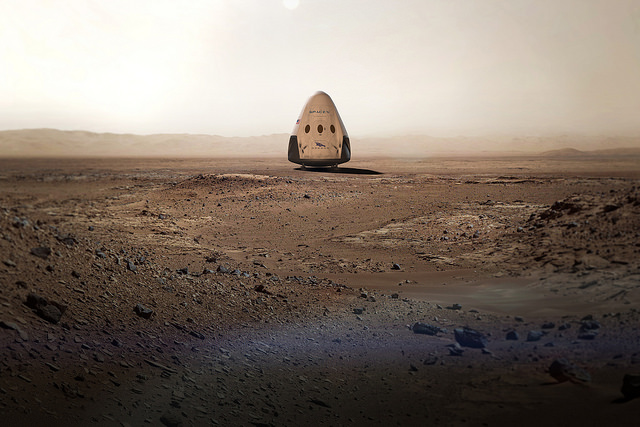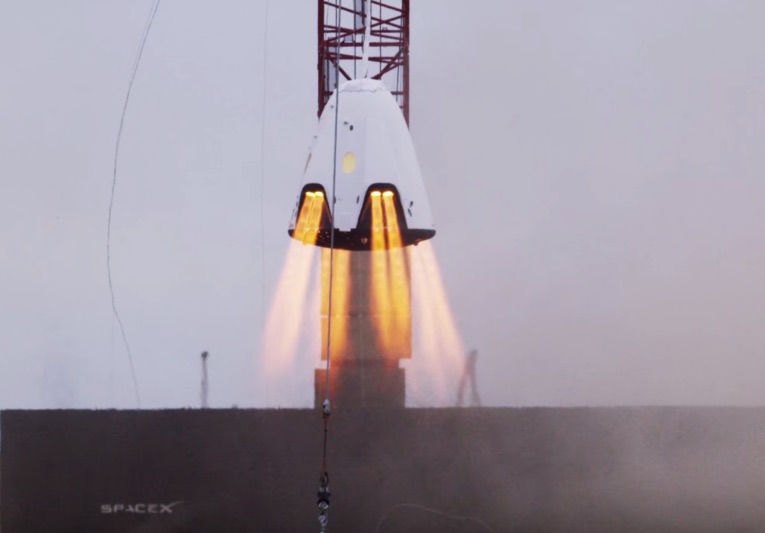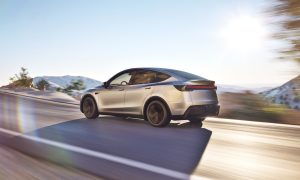

News
SpaceX Dragon 2 will not land propulsively, Red Dragon likely dead
ISS R&D 2017 – Washington D.C.
Answering questions from audience members, serial tech entrepreneur Elon Musk validated a large number of SpaceX rumors by confirming that the company’s Mars update at the International Astronautical Congress in late September would demonstrate a leaner architecture. Musk noted that the team has aimed partially at improving the economic viability of the vehicle, making it more applicable and useful for Earth orbit activities. This would involve downsizing the booster and spaceship, although Musk quickly added that it would be “a little bit smaller, but still big”.

Video of Dragon 2 hover test from SpaceX
Musk also confirmed rumors that SpaceX was no longer pursuing propulsive landing for Dragon 2 (Crew Dragon). He explained that the massive amount of effort that would have been required to qualify propulsive landing of crew and cargo was a major barrier. The main reason SpaceX has moved away from it, however, is a result of the company’s engineering expertise deciding that the Dragon 2 layout was not the best solution for landing on Mars. While the question was not proffered, nor details added, this probably means that there will be no Red Dragon missions, with SpaceX instead likely pursuing the development of its smaller Mars vehicle as quickly as possible.
Unlike the mockup revealed in 2015, the operational Dragon 2 will not have extendable legs, and would thus require some sort of cushion to land without severe damage to the vehicle and its crew and cargo. This engineering decision will likely impact the updated design of SpaceX’s Mars architecture, as the Interplanetary Transport System (ITS) was intended to utilize data SpaceX was to gather from Red Dragon missions in order to understand the environment ITS would face.
With Musk still planning on presenting a Mars update at 2017’s IAC in Adelaide, Australia, there will be many more fascinating details to be had in just over two months.

News
Elon Musk slams MSNBC for relating Trump’s terrorism warning to Tesla “protests”
“So just to be clear, you protest a private company, you are labeled by this administration a domestic terrorist,” MSNBC noted.

Tesla CEO Elon Musk has sharp words for MSNBC after the media outlet related U.S. President Donald Trump’s warning about attacks on the electric vehicle maker and its customers to acts of protest.
As per Musk, such a relation is insane, as extreme actions that have been taken against Tesla are not legitimate forms of protest.
Tesla Attacks
Amidst Elon Musk’s work with the Trump administration and his increasingly political nature, attacks against Tesla have seen a notable rise in the past months. Tesla showrooms have been shot up, vandalized, and set on fire in acts of alleged arson. Supercharger stations have also been set on fire. One Tesla store was even attacked with Molotov cocktails.
Worse, even private Tesla owners have seen their vehicles get attacked by vandals and critics. One Cybertruck owner noted on social media that one of his passengers actually got physically hurt when an anti-Tesla activist attacked his all-electric pickup truck.
In response to these attacks, Trump shared a stern warning to would-be Tesla attackers. As per Trump, anyone that hurts an American company, “especially a company like this that supplies so many jobs that others are unable to do,” will go through hell when they are apprehended.
MSNBC’s Response
In a segment, MSNBC framed the U.S. President’s warning as Trump simply looking out for a fellow billionaire—one whose company is failing. Interestingly enough, the media outlet’s hosts and panel did not mention or acknowledge any of the violent and dangerous attacks that have been directed at Tesla and Tesla owners as of late.
“You also, overnight, have his post claiming that protests at Tesla dealerships are illegal. He (Trump) said today he would label violence against dealerships domestic terrorism… So just to be clear, you protest a private company, you are labeled by this administration a domestic terrorist,” MSNBC noted.
Musk Strikes Back
Musk did not mince words in his criticism of the media outlet. In response to a video shared on X of MSNBC’s segment, Musk wrote, “Wow, they’re totally insane.” Musk also clarified the rather simple distinction that while peaceful protests are no issue, shooting Tesla stores and burning Superchargers are a step too far.
“Death threats, shooting up Tesla stores, and burning down Superchargers are definitely not “legitimate forms of protest!”” Musk wrote in his post.
News
Rivian supports Tesla despite all the Elon Musk hate

Rivian CEO RJ Scaringe showed some support for Tesla despite all the Elon Musk hate that has been spreading. Scaringe’s stance on all the Tesla amid the protests and vandalism starkly differs from what seems to be the popular opinion lately.
RJ Scaringe attended the South by Southwest (SXSW) event in Austin earlier this week. The Rivian CEO briefly talked about Tesla and its current predicament.
“When we look at Tesla and other manufacturers, I think it’s incredibly important that we have [a] choice. We need Tesla to be successful, we need other manufacturers to be successful,” answered Scaringe graciously.
In the past, Scaringe has talked about the electric vehicles industry’s growth and how EV automakers need to offer different designs to help it expand. He acknowledges that Tesla started the current EV revolution and once called it a “very inspirational” company. However, the Rivian CEO also encourages EV automakers to make their own mark in this rising industry.
“If you’re a consumer that’s thinking about buying a car and you want to spend less than $50,000, there are just not that many great electric options,” Scaringe noted during his SXSW appearance.
He noted that the base Tesla Model Y is less than $50,000 but also pointed out that it might be someone’s design or brand preference. In Rivian’s case, nature lovers were attracted to the company’s designs and features.
“I was sort of fortunate [to attract buyers who like nature]. I love the outdoors, active sports, and things like that,” Scaringe said. “But there’s also a strategy to realize that if we can build a product that enables and inspires people to be outdoors, it’s going to help people to want to be active participants in sustainability.”
Rivian signed a 2-year headlining sponsorship agreement with SXSW. It has planned plenty of fun activities and exhibits for the annual festival, including an Electric Roadhouse space inspired by Texas Roadhouse.
Rivian R1T and R1S demo drives are available at SXSW until the end of the event on March 15, 2025. The Rivian R2 will also be on display during the festival.
News
Meta taps X’s open-source algorithm for its own Community Notes system
Meta’s shift to a Community Notes-style fact-checking system was mentioned by CEO Mark Zuckerberg back in January.

Meta Platforms Inc. will begin tests of its Community Notes program, a crowd-sourced fact-checking system modeled after Elon Musk’s X, on March 18. Meta intends to use Community Notes on Facebook, Instagram, Threads.
The announcement was posted by Meta in a blog post on its official website.
Tapping Into X’s Model
Meta’s shift to a Community Notes-style fact-checking system was mentioned by CEO Mark Zuckerberg back in January. At the time, the CEO noted that Meta’s third-party fact-checkers had become “politically biased.” Interestingly enough, Meta’s Community Notes will build on X’s open-source algorithm.
As per the social media giant in its blog post: “We won’t be reinventing the wheel. Initially we will use X’s open source algorithm as the basis of our rating system. This will allow us to build on what X has created and improve it for our own platforms over time,” Meta wrote in its blog post.
Building on X’s System
Meta did note that it could eventually develop and explore adjusted iterations of the Community Notes system in the future. The company, however, remained optimistic that its X-inspired crowd-sourced fact-checking system would be “less biased than the third party fact checking program it replaces.”
“As X’s algorithm and program information is open source – meaning free and available for anyone to use – we can build on what X has done, learn from the researchers who have studied it, and improve the system for our own platforms. As our own version develops, we may explore different or adjusted algorithms to support how Community Notes are ranked and rated,” Meta wrote.
Experts Question Approach
Meta’s shift to a crowd-sourced fact-checking system has received polarizing reactions. Dan Evon of RumorGuard warned that Meta’s decision “not only removes a valuable resource for users, but it also provides an air of legitimacy to a popular disinformation narrative: That fact-checking is politically biased. Fact-checkers provide a valuable service by adding important context to the viral claims that mislead and misinform millions of users on Meta,” as noted in a report from the Associated Press.
-

 News6 days ago
News6 days agoTesla at risk of 95% crash, claims billionaire hedge fund manager
-

 News1 week ago
News1 week agoSpaceX announces Starship Flight 8’s new target date
-

 News6 days ago
News6 days agoTesla contract with Baltimore paused after city ‘decided to go in a different direction’
-

 News1 week ago
News1 week agoTesla launches fresh U.S. promotions for the Model 3
-

 Elon Musk1 week ago
Elon Musk1 week agoTesla mulls adding a new feature to fight off vandals as anti-Musk protests increase
-

 Elon Musk2 days ago
Elon Musk2 days agoPresident Donald Trump buys a Tesla at the White House – Here’s which model he chose
-

 Elon Musk1 week ago
Elon Musk1 week agoTesla UK sales up over 20% despite Elon Musk backlash
-

 News2 days ago
News2 days agoElon Musk comments on Tesla’s massive Monday stock slide





